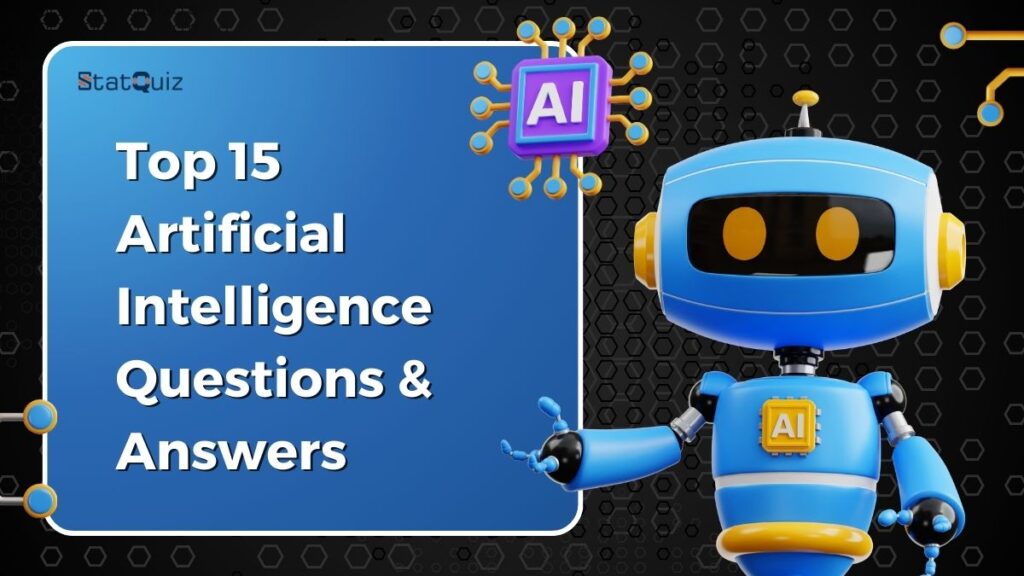Artificial Intelligence (AI) is a rapidly advancing field that has captured the imagination of technologists, researchers, and businesses worldwide. As AI continues to shape our world and redefine various industries, it’s essential to explore its fundamental concepts and applications through a series of questions and answers. In this compilation of the top 15 AI questions and their concise answers, we will delve into the core aspects of AI, shedding light on its significance, challenges, and potential. From understanding the basic principles to exploring the ethical dilemmas AI presents, this collection aims to provide a comprehensive overview of this transformative technology.
Now, let’s move on to the top 15 Artificial Intelligence Questions & Answers
Q1. The k-nearest neighbor machine learning algorithm (kNN) is:
Select one:
a. highly mathematical and computationally intensive.
b. a method that has little in common with regression.
c. regarded as a “lazy” learning method.
d. very complex in its inner workings.
Q2. The random forest (RF) model is a modification to what algorithm?
Select one:
a. complex bagging
b. simple bagging
c. complex boosting
d. simple boosting
Q3. When using support vector machines, in which stage do you select the kernel type (e.g., RBF, Sigmoid)?
Select one:
a. preprocessing the data
b. developing the model
c. experimentation
d. deploying the model
Q4. What is a major drawback to the basic majority voting classification in kNN?
Select one:
a. It requires frequent human subjective input during computation.
b. Classes that are more clustered tend to dominate prediction.
c. Even the naive version of the algorithm is hard to implement.
d. Classes with more frequent examples tend to dominate prediction.
Q5. Some of the benefits of the BN model include:
Select one:
a. ease of adaptability.
b. extent of applicability.
c. both ease of adaptability and extent of applicability.
d. none of these.
Q6. In the opening vignette, predictive modeling is described as:
Select one:
a. estimating the future using the past.
b. not yet accepted in the business world.
c. the least practiced branch of data mining.
d. unable to handle complex predictive problems.
Q7. Bagging can be used for:
Select one:
a. classification-type prediction problems.
b. regression/estimation-type prediction problems.
c. both classification-type prediction problems and regression/estimation-type prediction problems
d. none of these
Q8. Backpropagation requires the of vector pairs, with the pairs consisting of:
Select one:
a. an input vector and a control vector.
b. binary input vectors.
c. a control vector and a target vector.
d. an input vector and a target vector.
Q9. For how long do SVM models continue to be accurate and actionable?
Select one:
a. for as long as the developers stay with the firm
b. for as long as management support continues to exist for the project
c. for as long as you choose to use them
d. for as long as the behavior of the domain stays the same
Q10. Support vector machines are a popular machine-learning technique primarily because of:
Select one:
a. their relative cost and superior predictive power.
b. their superior predictive power and their theoretical foundation.
c. their relative cost and relative ease of use.
d. their high effectiveness in the very few areas where they can be used.
Q11. Which element in an artificial neural network roughly corresponds to a dendrite in a human brain?
Select one:
a. node
b. input
c. output
d. weight
Q12. Which element in an artificial neural network roughly corresponds to a synapse in a human brain?
Select one:
a. node
b. input
c. output
d. weight
Q13. Neural networks have been described as “biologically inspired.” What does this mean?
Select one:
a. They are faithful to the entire process of computation in the human brain.
b. They were created to look identical to human brains.
c. They crudely model the biological makeup of the human brain.
d. They have the power to undertake every task the human brain can.
Q14. When using support vector machines, in which stage do you transform the data?
Select one:
a. preprocessing the data
b. developing the model
c. experimentation
d. deploying the model
Q15. In the opening vignette, which method was the best in both accuracy of predicted outcomes and sensitivity?
Select one:
a. ANN
b. CART
c. C5
d. SVM
Answers
- c
- b
- b
- b
- c
- a
- c
- d
- d
- b
- b
- d
- c
- a
- d

